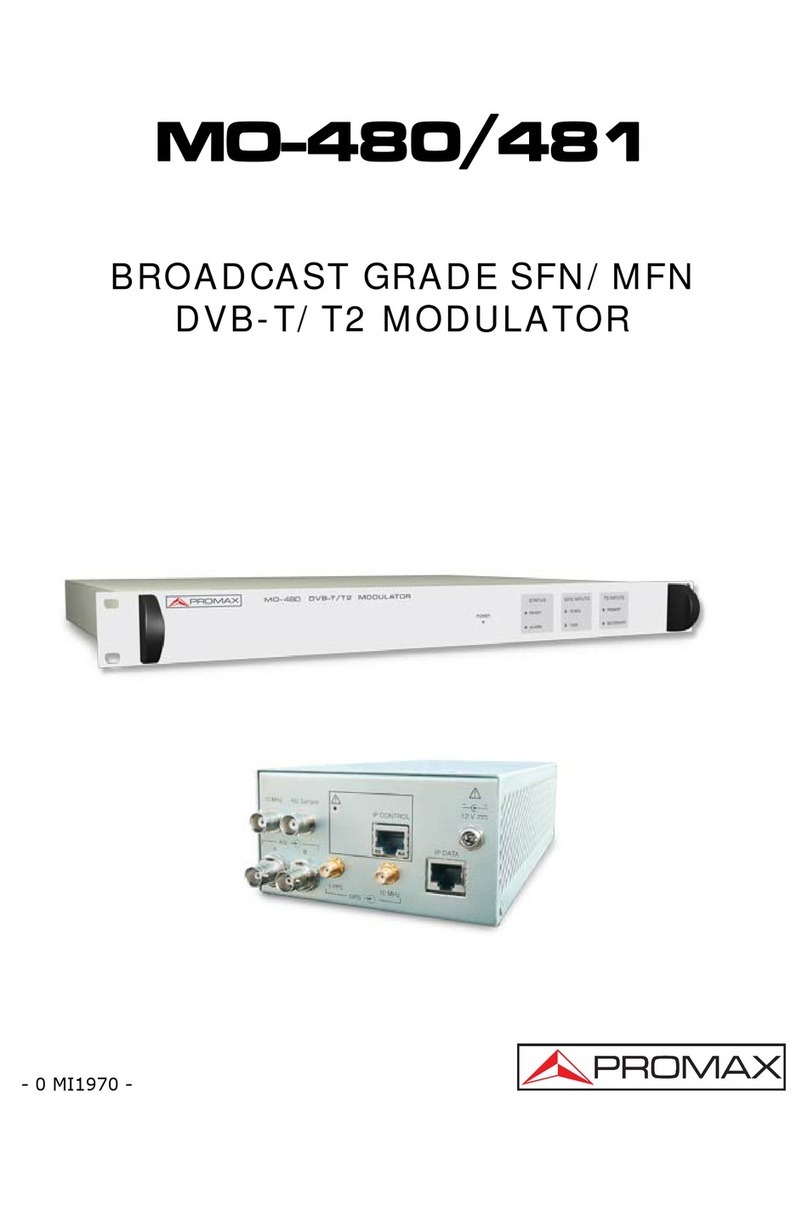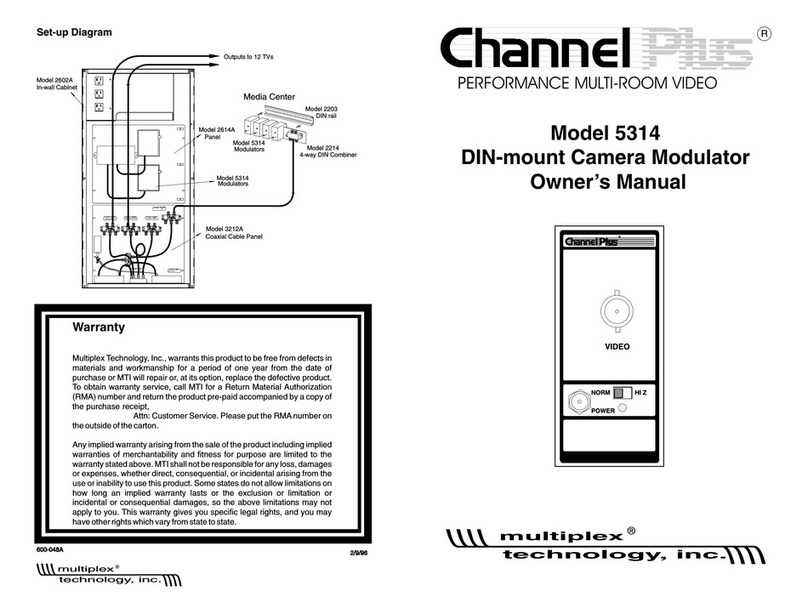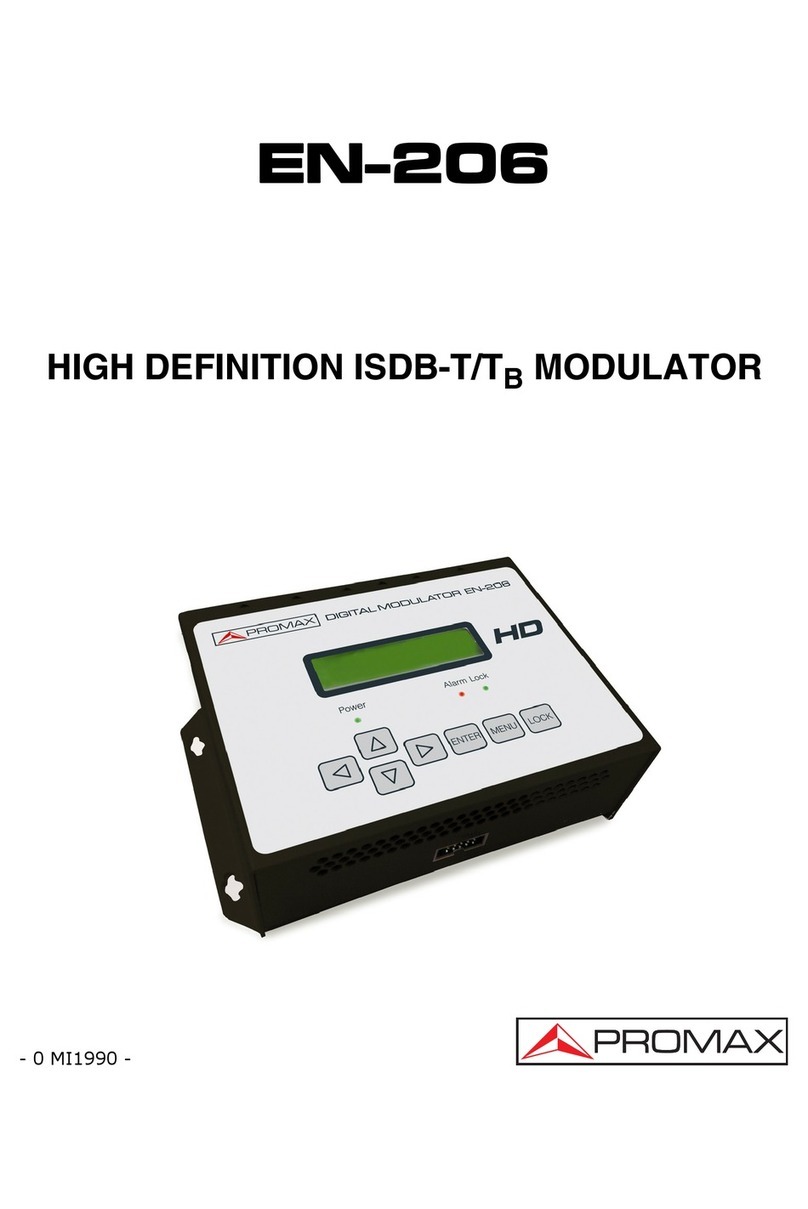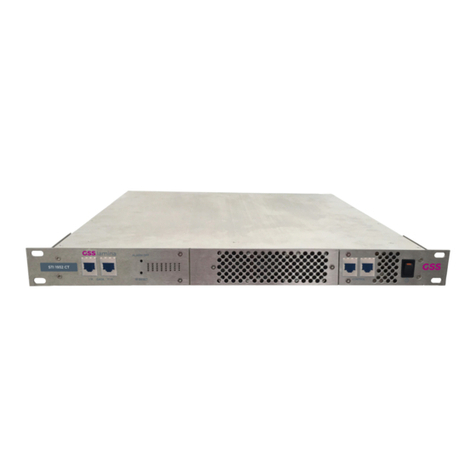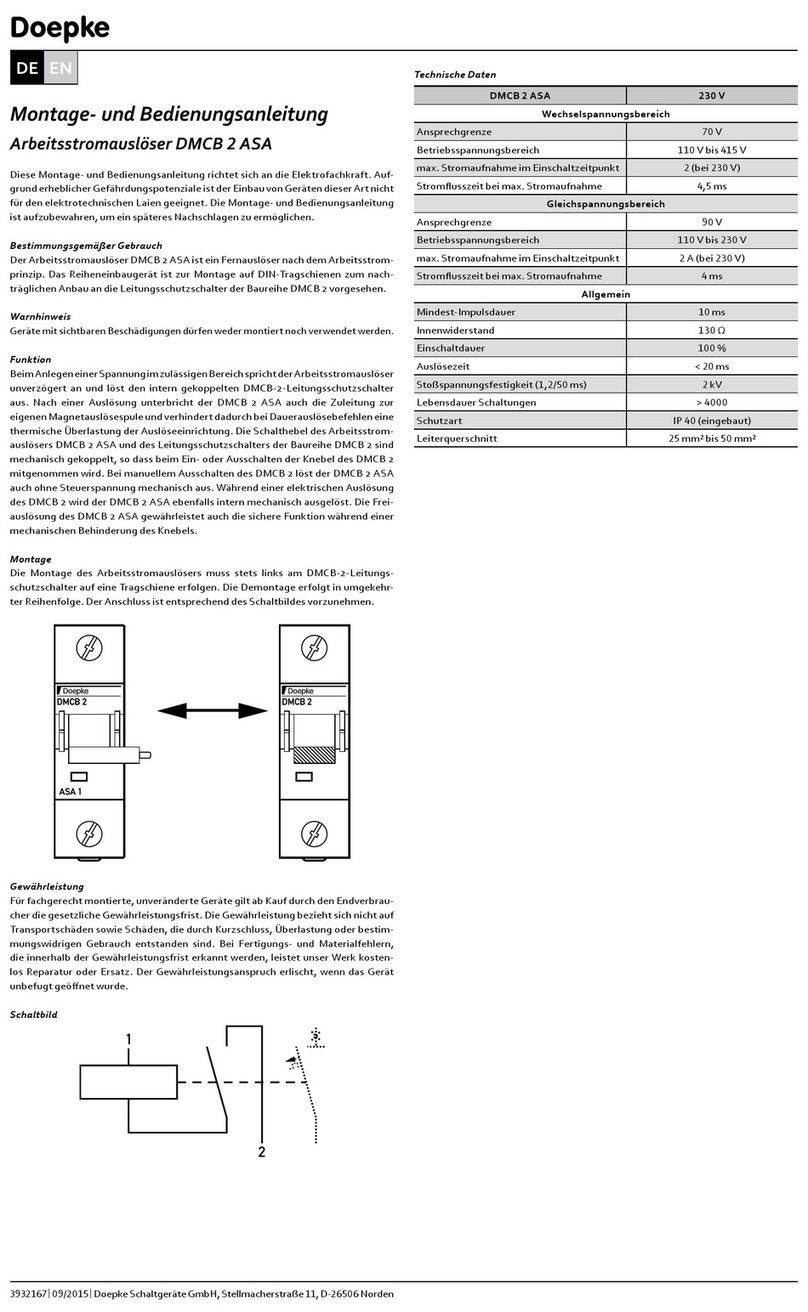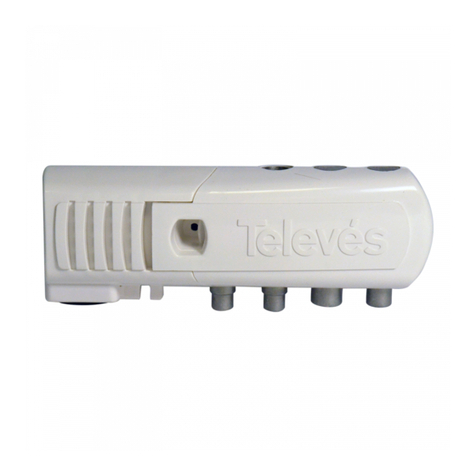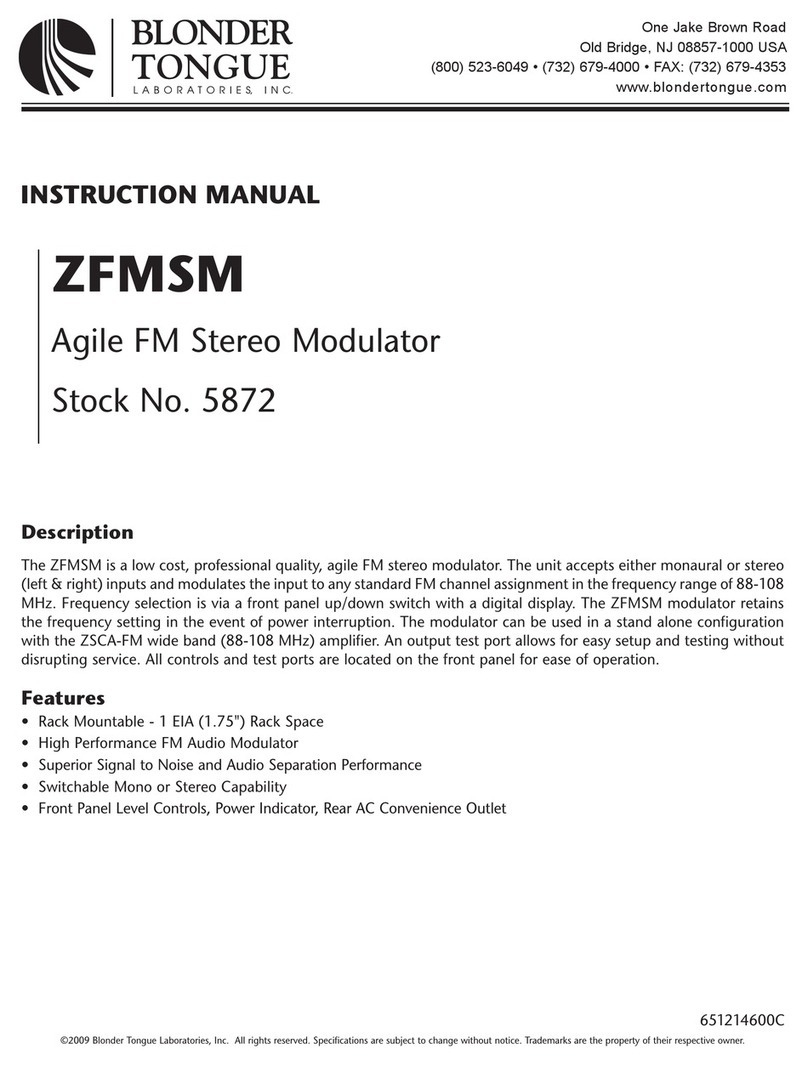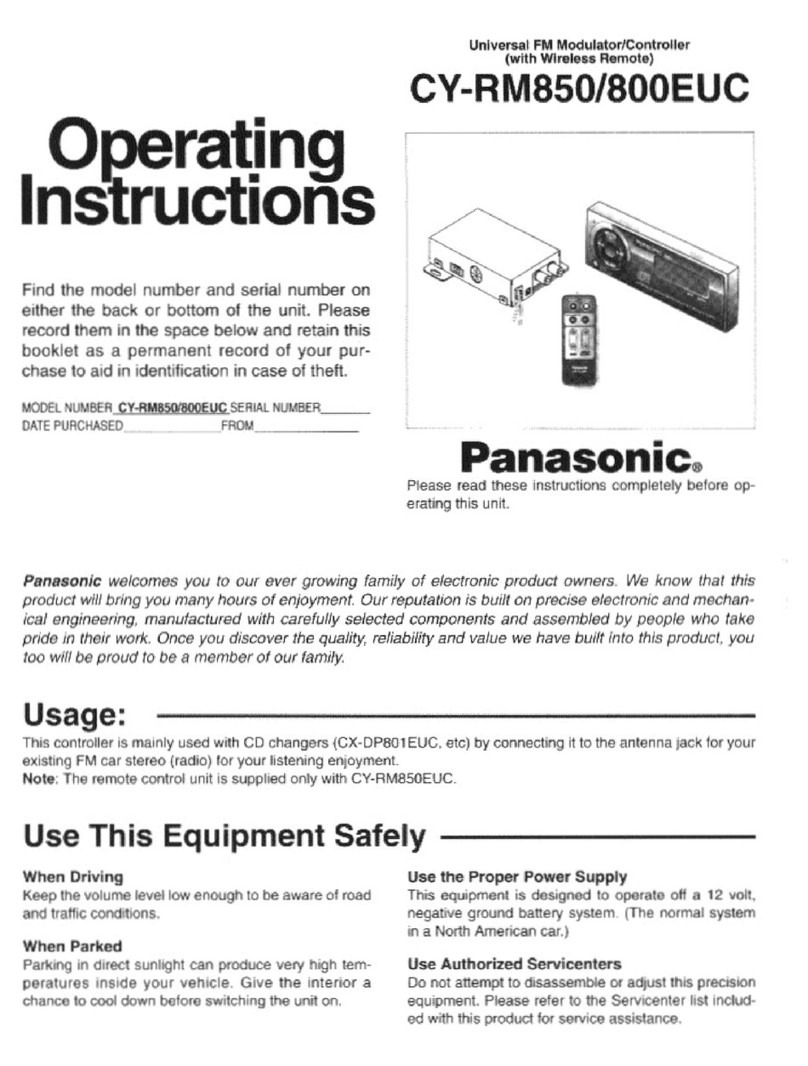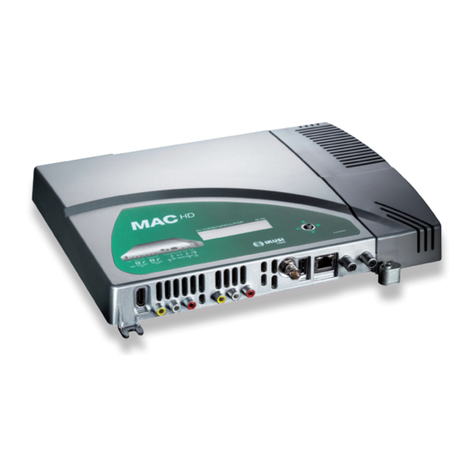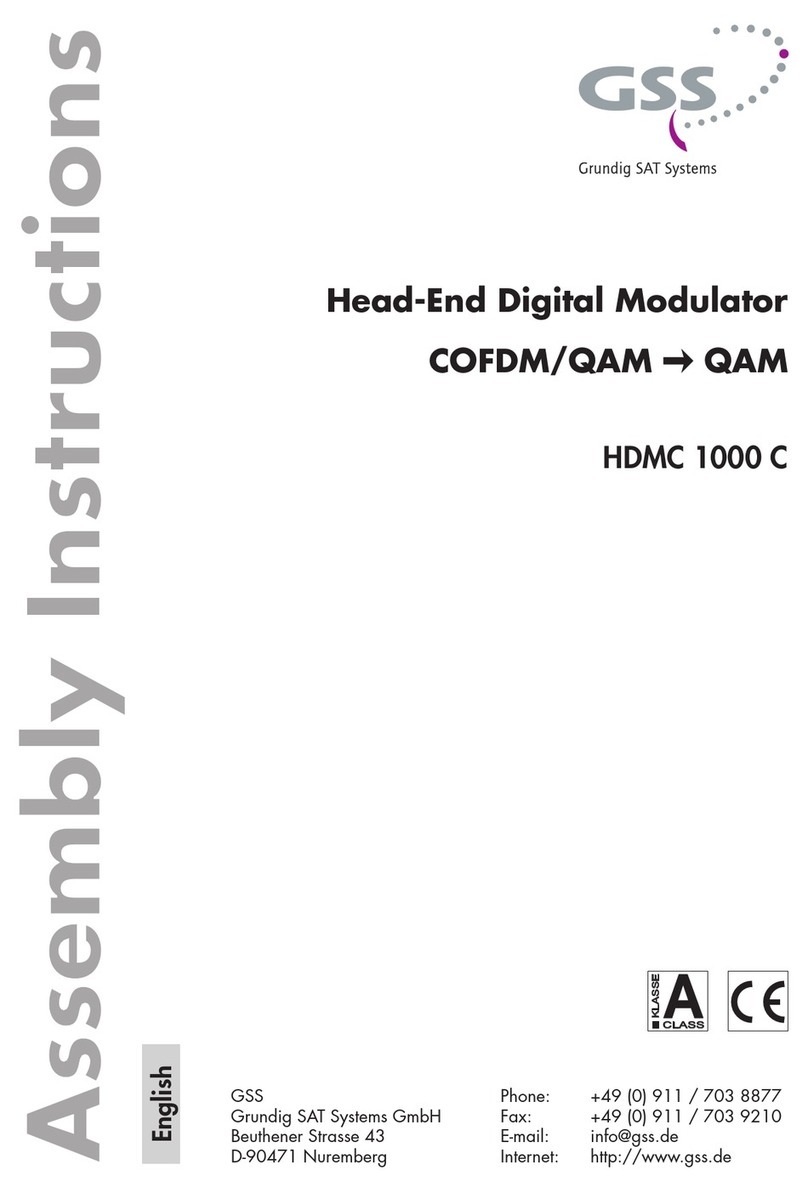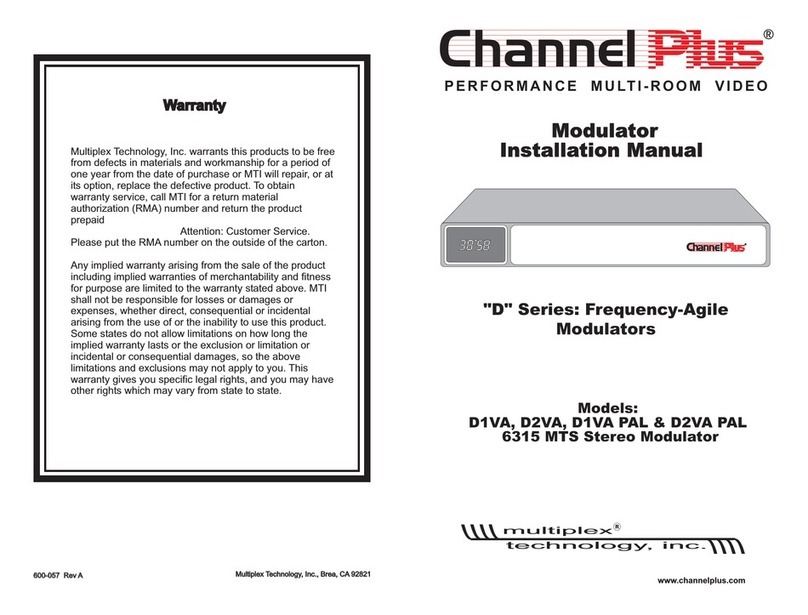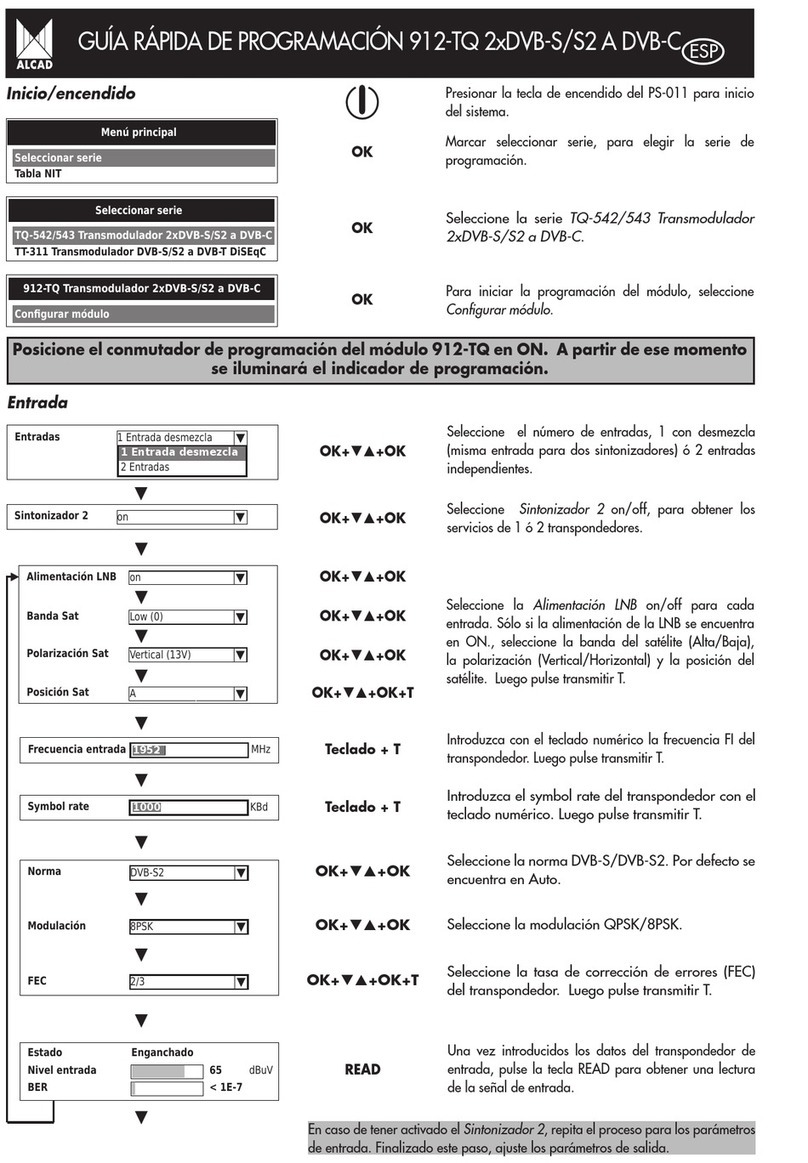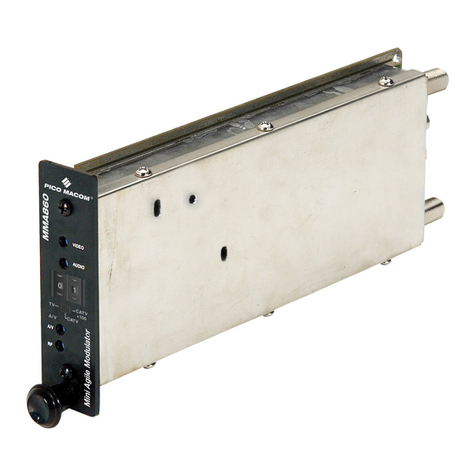General Instrument C6M-II User manual

C6M-II
Commander 6 Modulator
Installation Manual
®
ENT
20 80 87.5 95
520 25 30 50
REF OFF
VIDEO OFF
VIDEO B
AUX IF
PRGM IF
REMOTE
-20dB
TEST
RF OUT
VIDEO video modulation (%)
audio deviation (kHz)
C6M-II

Caution
These servicing instructions are for use by qualified personnel only. To reduce the risk of electrical shock, do not perform any servicing other
than that contained in the Installation and Troubleshooting Instructions unless you are qualified to do so. Refer all servicing to qualified service
personnel.
FCC Compliance
This equipment has been tested and found to comply with the limits for a Class A digital device, pursuant to Part 15 of the FCC Rules. These
limits are designed to provide reasonable protection against harmful interference when the equipment is operated in a commercial environment.
This equipment generates, uses, and can radiate radio frequency energy and, if not installed and used in accordance with the Installation Manual,
may cause harmful interference to radio communications. Operation of this equipment in a residential area is likely to cause harmful interference
in which case the user will be required to correct the interference at his own expense. Any changes or modifications not expressly approved by
General Instrument could void the user’s authority to operate this equipment under the rules and regulations of the FCC.
Canadian Compliance
This Class A digital apparatus meets all requirements of the Canadian Interference-Causing Equipment Regulations.
Cet appareil numérique de la classe A respects toutes les exigences du Règlement sur le matériel brouilleur du Canada.
Special Symbols That Might Appear on the Equipment
The symbol shown on the left, a reaching hand in a triangle with a slash through it, is intended to alert the user and
service personnel of the possibility of equipment damage or degradation of performance due to Electrostatic
Discharge (ESD) event.
The exclamation point, within an equilateral triangle, is intended to alert the user to the presence of important
installation, servicing, and operating instructions in the documents accompanying the equipment.
For continued protection against fire, replace all fuses only with fuses having the same electrical ratings marked at
the location of the fuse.
Copyright © 1997 by General Instrument Corporation.
All rights reserved.
No part of this publication may be reproduced in any form or by any means or used to make any derivative work (such as translation,
transformation or adaptation) without written permission from General Instrument.
General Instrument reserves the right to revise this publication and to make changes in content from time to time without obligation on the part of
General Instrument to provide notification of such revision or change.
General Instrument provides this guide without warranty of any kind, either implied or expressed, including, but not limited, to the implied
warranties of merchantability and fitness for a particular purpose. General Instrument may make improvements or changes in the product(s)
described in this manual at any time.
Commander 6 is a registered trademark of General Instrument Corporation.

Contents
Section 1 Introduction
Using This Manual ...................................................................................................... 1-2
Related Documentation .............................................................................................. 1-2
Document Conventions .............................................................................................. 1-2
If You Need Help .......................................................................................................... 1-3
Calling for Repairs ...................................................................................................... 1-3
Section 2 Overview
Options ........................................................................................................................ 2-1
C6M-II-MOB Kit ...................................................................................................... 2-2
C6-DC ..................................................................................................................... 2-2
C6-RC-II Kit ............................................................................................................ 2-2
C6M-II-SE Kit .......................................................................................................... 2-2
Model Conventions ..................................................................................................... 2-3
Front Panel Controls and Displays ............................................................................ 2-3
Rear Panel Connectors ............................................................................................... 2-5
The Menu System ........................................................................................................ 2-8
Using the Menus ..................................................................................................... 2-9
Changing a Menu Item ............................................................................................ 2-9
Main Menu .............................................................................................................. 2-10
Option Menu ........................................................................................................... 2-11
Video Menu ............................................................................................................. 2-13
Audio Menu ............................................................................................................. 2-13
Remote Menu ......................................................................................................... 2-14
Warning Messages ...................................................................................................... 2-15
Section 3 Installation
Before You Begin ........................................................................................................ 3-1
Mounting the Modulator ............................................................................................. 3-1
Checking the Operation .............................................................................................. 3-2
Switching Capabilities ................................................................................................ 3-3
Without the MOB Option Board ............................................................................... 3-3

ii Contents
With the MOB Option Board .................................................................................... 3-3
Automatic Gain Control ............................................................................................... 3-4
IF AGC .................................................................................................................... 3-4
Baseband AGC (Optional) ....................................................................................... 3-4
Audio Parameters ........................................................................................................ 3-5
Audio Impedance ..................................................................................................... 3-5
Audio Level .............................................................................................................. 3-5
Stereo Encoder (Optional) ....................................................................................... 3-5
Selecting the RF Channel Frequency Plan ................................................................. 3-5
Typical Interconnections ............................................................................................. 3-6
Basic Video and Audio Interfacing ............................................................................ 3-6
Satellite Link Connection .......................................................................................... 3-7
Satellite Link Connection with C6M-II-SE ................................................................. 3-8
Video Scrambling ..................................................................................................... 3-9
CW Output .............................................................................................................. 3-10
Stereo IF Interfacing ................................................................................................ 3-11
Composite Baseband Interfacing ............................................................................. 3-12
CMTS / MVP II / C6M-II Connections ...................................................................... 3-13
C6R-VCII / CMTS / MVP II / C6M-II Connections ..................................................... 3-14
Section 4 System Block Diagrams
Video to IF Modulation System ................................................................................... 4-1
Audio to IF Modulation System .................................................................................. 4-2
IF Switching and AGC System .................................................................................... 4-4
IF to Channel Converter System ................................................................................. 4-5
Appendix A Specifications
RF Output ..................................................................................................................... A-1
IF ................................................................................................................................... A-1
Video ............................................................................................................................ A-1
Audio ............................................................................................................................ A-2
General ......................................................................................................................... A-2
Appendix B Frequency Plan
Appendix C Changing a Menu Item
Appendix D Signal Priority Chart

Contents iii
Appendix E Application Notes
C6-LPF600 ................................................................................................................... E-1
Summary ................................................................................................................ E-1
Discussion .............................................................................................................. E-1
Specifications .......................................................................................................... E-2
Figures
Figure 1-1 Front and rear views of the C6M-II .............................................................. 1-1
Figure 2-1 C6M-II front panel ....................................................................................... 2-3
Figure 2-2 C6M-II rear panel with options installed ....................................................... 2-5
Figure 2-3 Menu relationships ...................................................................................... 2-8
Figure 3-1 Rack mounting ............................................................................................ 3-2
Figure 3-2 Operational check connections .................................................................... 3-3
Figure 3-3 Basic video/audio interfacing ....................................................................... 3-6
Figure 3-4 Satellite link connection ............................................................................... 3-7
Figure 3-5 Satellite link connection with stereo encoder................................................ 3-8
Figure 3-6 MVP II / C6M-II IF interfacing ...................................................................... 3-9
Figure 3-7 MVP II / C6M-II interfacing using the CW output .......................................... 3-10
Figure 3-8 C6M-II / CMTS IF interfacing ....................................................................... 3-11
Figure 3-9 External composite baseband connection.................................................... 3-12
Figure 3-10 C6M-II / MVP II / CMTS interfacing ............................................................. 3-13
Figure 3-11 C6R-VCII / CMTS / MVP II / C6M-II connections ......................................... 3-14
Figure 4-1 Video to IF modulation system .................................................................... 4-1
Figure 4-2 Audio to IF modulation system .................................................................... 4-2
Figure 4-3 IF switching and AGC system ..................................................................... 4-4
Figure 4-4 IF to channel converter system ................................................................... 4-5
Figure E-1 Typical installations of C6-LPF600 .............................................................. E-1
Tables
Table 2-1 Required revision levels .............................................................................. 2-1
Table 2-2 Description of controls and displays............................................................. 2-3
Table 2-3 Description of rear panel connections .......................................................... 2-6
Table 2-4 Description of Main menu items .................................................................. 2-10
Table 2-5 Description of Option menu items ................................................................ 2-11
Table 2-6 Description of Video menu items ................................................................. 2-13
Table 2-7 Description of Audio menu items ................................................................. 2-13
Table 2-8 Description of Remote menu items .............................................................. 2-14
Table 2-9 Description of flashing messages ................................................................ 2-15

C6M-II Installation Manual
Section 1
Introduction
The C6M-II is a state-of-the-art television signal modulator for the most demanding CATV
applications. The system is packaged in a space saving 1.75-inch high rack-mounted housing
and uses efficient switching power supply regulators to minimize power consumption and heat.
Features of the C6M-II include:
n
1 GHz tuning capability
n
Frequency selection in 12.5 kHz steps or channel map
n
Automatic source signal switching
n
Front panel user-friendly interface keypad
n
Easy to read LED display for system operational maintenance
n
Remote monitoring and control option
n
BTSC integrated stereo encoder option
n
dc power option
Front and rear views of the C6M-II are shown below without any options.
Figure 1-1
Front and rear views of the C6M-II

1-2 Introduction
C6M-II Installation Manual
Using This Manual
This manual includes information and instructions required to install and operate the C6M-II.
Section 1
Introduction
provides a brief description of the C6M-II, related documentation, the
helpline number and information about repair.
Section 2
Overview
describes the C6M-II, identifies the front panel displays and controls,
describes the rear panel connectors, and explains the menu system.
Section 3
Installation
provides instructions on how to install and operate the C6M-II.
Section 4
System Block Diagrams
describes functions of the unit with block diagrams.
Appendix A
Specifications
provides the technical specifications for the C6M-II.
Appendix B
Frequency Plan
lists the Frequency Plan.
Appendix C
Changing a Menu Item
illustrates how to change a menu item.
Appendix D
Signal Priority Chart
provides the priority chart for IF.
Appendix E
Application Notes
provides instructions for installing the C6-LPF600 (928-363-000)
or equivalent filter.
Related Documentation
The following documents describe equipment which can be used with the C6M-II:
n
Modulating Video Processor Model MVP-II Installation Manual
n
Satellite Receiver/Decoder Model C6R-VCII Installation Manual
n
Stereo Encoder Model CMTS Installation Manual
Although these documents provide information that may be of interest to you, they are not
necessary to install or operate the C6M-II modulator.
Document Conventions
Before you begin using the C6M-II, familiarize yourself with the stylistic conventions used in
this manual:
SMALL CAPS Denotes silk screening on the equipment, typically representing front and rear-panel
controls, I/O connections and indicators (LEDs).
* (asterisk) Indicates that there are several versions of the same model number and the information
applies to all models. When the information applies to a specific model, the complete
model number is given.

Introduction 1-3
C6M-II Installation Manual
If You Need Help
If you need assistance while working with the C6M-II, call the General Instrument Technical
Response Center at 1-888-GEN-INST (1-888-436-4678). The Technical Response Center is
open from 8:00 a.m. to 9:00 p.m. Eastern Time, Monday through Friday. When the Technical
Response Center is closed, emergency service only is available on a call-back basis.
When contacting the Technical Response Center from outside the United States, please use our
main switchboard number, 1-215-674-4800, extension 4200.
Calling for Repairs
If repair is necessary, call the General Instrument Repair Facility at 1-800-227-0450 for a
Return for Service Authorization (RSA) number before sending the unit. The RSA number
must be prominently displayed on all equipment cartons. The Repair Facility is open from
8:00 a.m. to 5:00 p.m. Central Time, Monday through Friday.
If calling from outside the United States, dial your appropriate international access code, then
dial 52-891-40739, to contact the Repair Facility.
When shipping equipment for repair, follow these steps:
Pack the unit securely.
Enclose a note describing the exact problem.
Enclose a copy of the invoice that verifies the warranty status.
Ship the unit PRE-PAID to the following address:
GI Communications
2009 McKenzie Road
Suite 102
Carrollton, TX 75006
Attn: RSA #___________

C6M-II Installation Manual
Section 2
Overview
The C6M-II is a frequency agile modulator offering an output frequency range from 50 MHz to
1 GHz. All standard, HRC, IRC, and EIA frequencies are available either by keying in the
frequency or using the convenient channel maps.
The C6M-II provides local control by using a front panel user interface. This interface is a
menu system that provides easy access to operating parameters that are microprocessor
controlled for precision, accuracy, stability, and reliability.
Upon frequency or channel selection, the microprocessor automatically engages internal
bandpass filters, ensuring that a combined carrier-to-noise (c/n) ratio of greater than 60 dB is
always maintained with no external filtering required. The c/n performance is guaranteed in
multi-channel combined systems up to 149 channels with a typical performance of 63 dB c/n,
normalized to 4 MHz.
The precision frequency stability of the C6M-II meets the band frequency accuracy
requirements for the FCC. The FCC mandated frequency offsets of +12.5 kHz and +25 kHz are
generated automatically. The C6M-II also exceeds all FCC RF and baseband signal
performance requirements.
Options
The options available for the C6M-II are:
n
Modulator Option Board, model C6M-II-MOB Kit
n
DC Power Option Board, model C6-DC
n
Remote Control Option Board, model C6-RC-II Kit
n
Stereo Encoder Option Board, model C6M-II-SE Kit
The C6M-II must have a minimum firmware revision to install the options. The following table
provides the required revision level.
Table 2-1
Required revision levels
Option C6M-II Firmware Revision
C6M-II-MOB 2.0 or higher
C6-RC-II 1.0 or higher
C6M-II-SE 2.0 or higher
The firmware revision can be found using the Option menu. If the revision in not correct,
please contact General Instrument Technical Response Center for assistance.

2-2 Overview
C6M-II Installation Manual
C6M-II-MOB Kit
The C6M-II-MOB accessory module provides baseband audio and video switching, audio and
video AGC, a 4.5 MHz audio subcarrier input, and switched IF input capabilities. The video
switching system includes video A signal sensing to allow automatic switching to video B input
when the video A signal is absent. The audio A and audio B input selection is controlled by the
same circuitry as the video switch section, ensuring the audio input switching follows the video
selection automatically. A rear panel connection allows external control of the input source
switching.
Defeatable video and audio AGC is for applications involving baseband signal levels. Preset
modulation levels are maintained despite fluctuations in the audio/video input levels from the
source or resulting from switching between baseband sources.
An additional IF signal input labeled PROGRAM is identical to the AUX IF switching except
that it has a lower switching priority. The PRGM IF switch is used for program switching or
automatic program replacement when video A and/or video B are absent.
The MOB accessory also accepts the external 4.5 MHz input. The 4.5 MHz input is for audio
interfacing to the output of a stereo encoder, satellite receivers, or demodulator.
C6-DC
The dc power input option accepts a dc input in the range of −20 to −60 Vdc. This option, which
includes a dc-to-dc converter and a rear panel dc inlet, replaces the standard ac power input.
This option is only available from the factory.
C6-RC-II Kit
The C6-RC-II accessory module allows the modulator to be remotely control via a personal
computer. All front panel controls, operating parameters, and adjustments can be monitored
and changed from a remote location. This kit includes a remote control communications board
with an RS-485 type interface using RJ-12 connectors.
C6M-II-SE Kit
The C6M-II-SE is a stereo encoder option for generating stereo sound. It encodes baseband
audio based on BTSC standards, and employs dbx-TV noise reduction circuitry to ensure a
quality signal. This option does not have Second Audio Program (SAP). For SAP applications,
the CMTS should be used.

Overview 2-3
C6M-II Installation Manual
Model Conventions
The model as it appears on your unit will reflect the options that are factory installed. The
basic modulator unit without any options is C6M-II-XXXX. The naming conventions are shown
below:
For example, if your model is C6M-II-MXRX, the modulator option board and the remote
control board have been factory installed. The C6MP-II-XXXX is equipped with the external
phase lock capability.
Front Panel Controls and Displays
The front panel of the C6M-II modulator, which includes an operational display, test ports, a
keypad for adjustments, a bar graph and a status display, is illustrated in Figure 2-1.
Figure 2-1
C6M-II front panel
The following table describes the function of each item on the C6M-II front panel.
Table 2-2
Description of controls and displays
Key Feature Description
AThe −20 dB RF test point connector provides a sample of the
rear panel RF output signal (marked RF OUT). The signal level
measured at this connector is −20 dB nominal relative to the
RF output level at the rear panel. The performance of the
unit should not be measured using this test point. This is an
F-type coaxial connector.

2-4 Overview
C6M-II Installation Manual
Key Feature Description
BThe VIDEO OUT provides a buffered video output. This is a
BNC type coaxial connector.
CThe eight-digit alphanumeric LED display shows all functions
and controls used to operate the C6M-II.
DThe keypad with four arrow push buttons is used to navigate
through the menus. When the desired menu item is reached,
the right arrow key is used to access the functions.
EThe ENT (Enter) key implements changes made to functions
and menus.
FThe LED bar graph monitors either depth of video modulation
or audio deviation. The desired function (either VIDEO or
AUDIO) can be selected in the Option menu BAR VID.
GThe operating status display contains the following six LED
indicators:
REF OFF Lights when a comb generator signal is not
applied to the rear panel REF IN connector or
when the reference signal level is too low (or
missing) for phase lock operation. This function
applies only to units with phase lock capability.
VIDEO OFF Lights when the video signal is absent or when
there is insufficient video signal level at the
selected input, VIDEO Aor VIDEO Bconnector.
VIDEO B Lights when VIDEO B is selected as the video
input. This applies only if the modulator option
board is installed.
AUX IF Lights when the AUX IF input is selected. The
input signal at this connector is routed to the
upconverter and then to the desired RF output.
PRGM IF Lights when the optional Program IF input is
selected for upconversion to the desired RF
output. This IF input is available only when the
modulator option board is installed.
REMOTE Lights when the remote control function is
activated through the menu. Available only
when the remote control option is installed.

Overview 2-5
C6M-II Installation Manual
Rear Panel Connectors
The rear panel of the C6M-II modulator with options installed is illustrated in Figure 2-2.
Figure 2-2
C6M-II rear panel with options installed
Note: All external jumpers take precedence over menu selection. This includes AUX IF,
VIDEO B, SUBCARRIER, and PRGM IF.
WARNING! RF OUT is a high performance RF connector.
Using a cable with a male connector of incorrect
dimensions may cause physical damage. The center
conductor diameter must be less than 32 ±2 mil
(0.8 ±0.05 mm) and shorter than 125 mil (3.2 mm)
measuring from the edge of the connector as illustrated.

2-6 Overview
C6M-II Installation Manual
The following table describes the features on the rear panel of the C6M-II modulator.
Table 2-3
Description of rear panel connections
Key Feature Description
APower line connector. Label indicates input power range.
BREF OUT and REF IN connectors are used to apply comb generator
reference signals for phase-locked operation. Applicable only for
units with the phase lock option. The REF OUT connector is a loop
through connection from the REF IN connector with an insertion
loss of 1.0 dB maximum. The frequency of REF IN must be 6 MHz.
These are F-type coaxial connectors.
CThe EXT SUBCARRIER IN connector accepts a monophonic or stereo
FM modulated 4.5 MHz audio subcarrier signal with a level of 50
to 200 mV rms. It also accepts composite baseband (video plus
4.5 MHz subcarrier). Available only when the modulator option
board is installed. This is a F-type coaxial connector.
DRF OUT connector. This is the RF channel output. The modulated
video and audio carrier signals appear here. The output level is
adjusted through the menu. This is an F-type coaxial connector.
EThe CW OUT connector provides a + 50 dBmV minimum
unmodulated picture IF carrier for use with the MVP-II video
processor. This is an F-type coaxial connector.
FREMOTE connectors. See the remote control option installation
manual for details on the function of these connections.
GSIF OUT and SIF IN connectors are jumpered during normal
operation. The SIF OUT connector has FM modulated sound IF
signal (41.25 MHz) at a nominal level of 10 to 30 dBmV,
depending on the audio level selected on the main menu. The SIF
IN connector is capable of passing a monophonic or stereo
modulated sound IF carrier. These are F-type coaxial connectors.
HPIF OUT and PIF IN connectors are jumpered during normal
operation. PIF OUT can be used to interface with an IF scrambler.
The PIF OUT connector is a modulated picture IF carrier at a
nominal level of 35 dBmV. Since the PIF IN connector precedes a
sound acoustic wave (SAW) filter, a composite IF signal (picture
IF plus sound IF) should not be applied to the PIF IN connector.
These are F-type coaxial connectors.
ISUBCARRIER, PRGM IF, AUX IF, and VIDEO B selection terminals are
activated by connecting them to one of the ground terminals on
the strip. When equipped with the stereo encoder option and
modulator option board, AUDIO B/SE input is available. Audio B is
monaural only. The functions of these features are described in
Section 3, Installation
.

Overview 2-7
C6M-II Installation Manual
Key Feature Description
JThe COMP IF OUT connector provides access to the internally
modulated composite IF signal at a nominal 30 dBmV level. The
video and audio correspond to the signal selected from the VIDEO
A/B and AUDIO A/B inputs, subcarrier or composite baseband (video
plus 4.5 MHz subcarrier inputs). If no video or audio signals are
present at the selected input, the signal consists of unmodulated
picture and sound carriers. This is an F-type coaxial connector.
KThe AUX-IF input connector accepts an alternate composite IF
signal. This input precedes the IF gain control circuitry and can
accept a level range from 25 to 35 dBmV. This is an F-type
coaxial connector.
LAUDIO A input is normally a balanced 600 ohm input with a ground.
This can be switched using the menu to a high impedance input
(15 kohms). To switch to the high impedance input, choose
AUDZ HI on the Audio menu. The optional AUDIO Binput is
identical to the AUDIO A input and is activated whenever the VIDEO B
input is selected.
MPRGM-IF input has the same signal characteristics as the AUX IF
input. Available only when the modulator option board is installed.
This is an F-type coaxial connector.
NVIDEO IN A is the primary video input connector (75-ohm baseband
video). VIDEO IN B is an optional input available only when the
modulator option board is installed. VIDEO IN B may be selected
through the video menu or by shorting to ground the VIDEO B
terminal on the rear panel. VIDEO IN B will be activated in when
loss of video is detected on VIDEO IN A if this feature is enabled
through the menu. These are BNC type coaxial connectors.

2-8 Overview
C6M-II Installation Manual
The Menu System
The C6M-II is operated by menus which are accessed by the four push buttons and the ENT key
located on the front panel. The relationship of the menus is shown graphically in Figure 2-3.
Figure 2-3
Menu relationships

Overview 2-9
C6M-II Installation Manual
Using the Menus
When the unit is powered, the first item on the Main menu appears on the LED display. To
reach any other main menu item, use the up or down arrow key. To move to the Option, Audio,
Video, or Remote menu, select its name on the LED display (via the Main menu) and then
press the right arrow key. To return to the Main menu, press the left arrow key.
To change a menu item, display the desired item and press the right arrow key. This will
cause the changeable portion to flash. Press the up or down arrow keys until the desired item
or value is reached. Press ENT to implement the new value. If the new value is not
implemented, the item will return to its previous state after a short delay.
If the display shows NA, it indicates Not Available or Not Applicable.
Changing a Menu Item
When changing any menu item, follow these general procedures:
If the item is located on the Main menu, display it using the up and down arrow keys.
If the item is located on the Option, Audio, Video or Remote menu, use the up or down
arrow key to display its name on the Main menu. Press the right arrow key to display the
first item on the desired menu. Then use the up or down arrow key to display the menu
item you wish to change.
Once you display the menu item you want to configure, press the right arrow key. The
changeable portion of the menu item flashes.
Use the up or down arrow key to change the value to the desired value or option.
To implement the change, press the ENT key.
If you decide not to make the change, press the left arrow key to exit the menu, or take no
action. If you take no action, the flashing value will revert to the previous value after a
short delay.
See Appendix C, Changing a Menu Item for a step-by-step description of how to change a menu
item.

2-10 Overview
C6M-II Installation Manual
Main Menu
The following table illustrates the display and describes the function of each item on the Main
menu.
Table 2-4
Description of Main menu items
Main Menu Item Appearance Description
Channel/Frequency Displays the channel number or frequency of the RF
output.
Identity Alphanumeric display of name assigned to the
modulator by the user.
Input Selection Allows switching by menu to VIDEO A, AUX IF, or the
optional inputs: VIDEO B, EXT SUBCARRIER IN
COMPOSITE BB IN or PRGM IF.
Video Modulation Adjusts the depth of video modulation. Increase or
decrease by holding down the up or down arrow key
until the desired depth is reached. Press ENT to
implement the change. When in this menu, the LED
bar graph display indicates the depth of modulation.
Audio Deviation Adjusts the deviation of FM modulation. Increase or
decrease by holding down the up or down arrow key
until the desired deviation is reached. Press ENT to
implement the change. When in this menu, the LED
bar graph display indicates audio deviation.
RF Output Level Adjusts the RF output level. Increase or decrease by
holding down the up or down arrow key until the
desired level is reached. Press ENT to implement the
change.
Audio/Video
Separation Adjusts the amplitude separation between the audio
and video carriers. Increase or decrease by holding
down the up or down arrow key until the desired level
is reached. Press ENT to implement the change.
Option Menu Provides access to the option menu. Press the right
arrow key to enter the option menu.
Video Menu Provides access to the video menu. Press the right
arrow key to enter the video menu.
Audio Menu Provides access to the audio menu. Press the right
arrow key to enter the audio menu.

Overview 2-11
C6M-II Installation Manual
Main Menu Item Appearance Description
Remote Menu Provides access to the remote menu when the option
is installed. NA means not available.
Option Menu
To access the Option menu, display OPT MENU on the Main menu. To reach any item on the
menu, use the up or down arrow key. The following table describes each item on the Option
menu.
Table 2-5
Description of Option menu items
Option Menu Item Appearance Description
RF Squelch Allows RF output to be turned on or off. The right
arrow key causes the item (e.g., ON) to flash. The up
arrow key toggles between ON and OFF. Pressing
ENT implements the choice. This menu item is mainly
for testing, and should always be ON for normal
operation.
Tuning Mode Selects the frequency plan. The choices are IRC,
HRC, STD, FRQ, and EIA. The right arrow key
causes the choice (e.g., STD) to flash. The up or
down arrow key pages through the flashing choices
(IRC, HRC, STD, FRQ, EIA). The ENT key implements
the choice. If FRQ is chosen, the RF output frequency
appears and the desired frequency must be entered by
using the up or down arrow key. For any other choice
(e.g., STD) the channel number flashes. The channel
number must then be entered by using the up or down
arrow key. After selecting the channel number, press
ENT to implement the choice. When the change is
made, the system automatically exits to the Main
menu.
Bar Graph Display Indicates whether the LED bar graph is being used to
display video depth of modulation or audio deviation.
The right arrow key causes the item to flash, and the
up or down arrow key toggles between VID (video
modulation) and AUD (audio deviation). Pressing ENT
implements the choice.
Automatic Gain
Control (IF AGC) Toggles IF AGC between ON (IAGC ON) and OFF
(IAGC OFF) For normal operation, it should be on.
Manual Gain Control
(IF MGC) If IF AGC is turned off, MGC is available.

2-12 Overview
C6M-II Installation Manual
Option Menu Item Appearance Description
Auxiliary IF AUTO Turns ON or OFF the option to use Auxiliary IF
automatically if video signals (A or B) are lost.
Program IF AUTO This is available only if the modulator option board is
installed. Turns ON and OFF the option to use
Program IF automatically if video A or B signals are
lost.
Model Number Displays the model designation of the unit.
Firmware Revision Displays the firmware revision number.
Test Inputs Selects the input sources to the unit. The selection is
not permanent. Used for testing or troubleshooting
input sources. CMP, SUB, VB, and PGM are available
only if the modulator option board is installed.
Phaselock AUT indicates that the REF IN connector is available to
automatically accept and lock an external
phase-locked reference signal. INT allows use of the
internal reference signal even if REF IN is available.
Address High Displays the first seven characters of the unit remote
control address. The address is same as the serial
number. Address is factory programmed and cannot
be changed.
Address Low Displays the last six characters of the unit remote
control address.
This manual suits for next models
1
Table of contents
